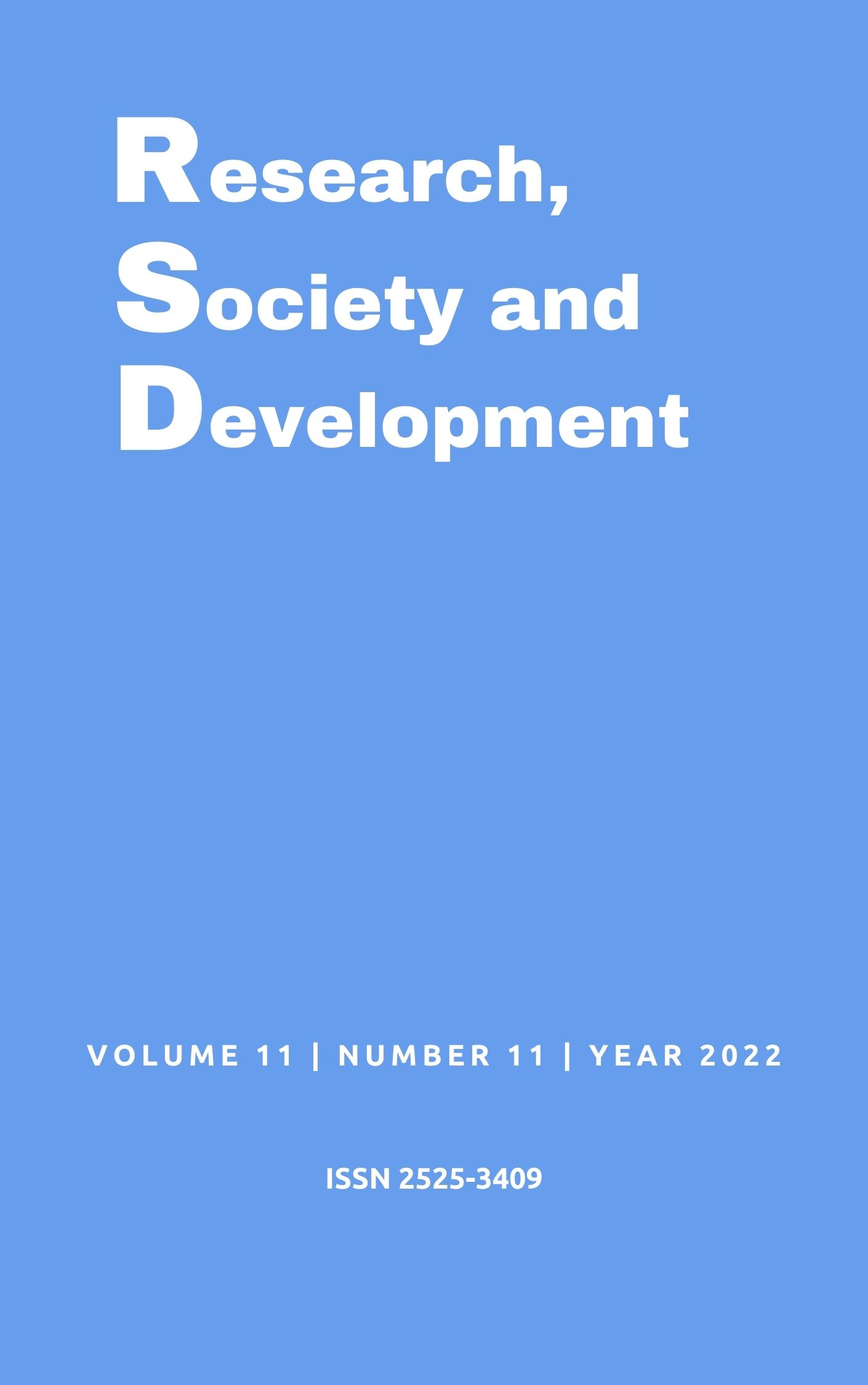Importance of the use of the sterile glove by nurses in the performance of dressings in the hospital environment: integrative review
DOI:
https://doi.org/10.33448/rsd-v11i11.33769Keywords:
Nursing care, Wounds and injuries, Infection of the wounds.Abstract
Gloves used in health care are indicated as a protective barrier for health professionals, especially biological risk, and are part of Personal Protective Equipment. The performance of dressings aims to protect the injury or wound from the action of external agents and may be physical, chemical or biological, besides providing cleaning, absorption of exudatos, immobilization and pain relief. Three different types of materials can be used: dressing kit, sterile glove and procedure glove. The study is an integrative review of the literature, is based on the question: What is the importance of the practice of the use of sterile gloves by nurses in the performance of dressings in the hospital environment? It aims to seek scientific evidence in the light of the literature that allows analyzing the practice of the use of sterile glove by nurses to perform dressings and the effectiveness of the sterile technique in this procedure. There are no absolute concepts regarding the clean and sterile technique in the most diverse situations in which patients can present. However, it can be understood that the practice of stereo technique in the hospital environment becomes safer for the prevention of infections in skin wounds. And that the use of sterile gloves cannot be classified as an incorrect technique.
References
Azevedo, I. C.; Costa, R. K. S; & Júnior, M. A. F. (2018). Perfil da produção científica da enfermagem nacional sobre feridas. Revista Cubana de Enfermería; 34(1):233-246.
Cauduro, F.P.; Schneider, S. M. B.; Menegon, D. B., et al. (2018). Atuação dos enfermeiros no cuidado das lesões de pele. Rev enferm UFPE on line., Recife, 12(10):2628-34. https://doi.org/10.5205/1981-8963-v12i10a236356p2628-2634-2018
Du gas, B. W. (1988). Enfermagem prática. (4ª ed.). Guanabara.
EndNote Web (2021). [place unknown]; https://access.clarivate.com/login?app=endnote
Ferreira, A. M.; & Andrade, D. (2008). Revisão integrativa da técnica limpa e estéril: consensos e controvérsias na realização de curativos. In: Acta Paul Enferm; 21(1):117-21.
Ferreira, A. M. (2004). Feridas infetadas: método, diagnostico e condutas de enfermagem. Acta Paul. Enf., São Paulo, 17(2), 189-94.
Ferreira, A. M.; Andrade, D. (2008). Revisão integrativa da técnica limpa e estéril: consensos e controvérsias na realização de curativos. Rev Acta Paul Enferm ;21(1):117-21.
Ferreira, A. M.; Bertolo D.; Andrade M. R.; & Andrade D. (2009). Conhecimento da equipe de enfermagem acerca do uso de luvas no contexto hospitalar. Ver. Eletr. Enf. [Internet]; 11(3): 628-34. Disponível em:http://www.fen.ufg/revista/v11/n3/v11n3a21.htm.
Gonzaga, M. H. H.P. O. A.; Felix, L.G.; Mendonça, A. E. O.; Silva, A. C . O.; Oliveira, S. H. S.; Carvalho, P. S., et al. (2022). Validity of an instrument on Nursing care for people with chronic wounds. Rev Rene;23:e71367. DOI: https://doi.org/10.15253/2175-6783.20222371367
Mendes, K. D. S., Silveira, R. C. C. P. & Galvão, C. M. (2008). Revisão integrativa: método de pesquisa para a incorporação de evidências na saúde e na enfermagem. Texto Contexto Enferm, Florianópolis, 17(4),758-764. http://www.scielo.br/pdf/tce/v17n4/18.pdf.
Ministério da Saúde (2009). NR 32. Conselho Regional de Enfermagem de São Paulo.
Ministério da Saúde (2008). RDC N° 5 de 15 de fevereiro de 2008. Disponível em .
Padula, M.; Medeiros fossatti, B. H.; & Armani oliveira, J. (2011). Utilização da técnica estéril na realização de curativos pela equipe de enfermagem. In: Saúde Coletiva, vol. 8, nº 50,, pp. 114-119. Editorial Bolina. São Paulo, Brasil. Disponível em: http://www.redalyc.org/articulo.oa?id=84217984004. Acessado em 08/07/2022.
Page, M. J.; Mckenzie, J. E.; Bossuyt, P. M.; Boutron, I.; Hoffmann, T.C.; & Mulrow, C. D.; et al. (2021). The PRISMA 2020 statement: an updated guideline for reporting systematic reviews. BMJ ;372:n71. doi: 10.1136/bmj.n71
Paula, V. A. A.; Souza, I. D.; Almeida, R. L. M.; & Santos, K. B.(2019). O conhecimento dos enfermeiros assistenciais no tratamento de feridas. HU rev; 45(3):295-303. DOI: 10.34019/1982-8047.2019.v45.28666.
Peters, M. D. J. et al. (2015) Guidance for conducting systematic scoping reviews. Int J Evid Based Healthc ,13(3), 141- 146.https://www.researchgate.net/publication/319713049_2017_Guidance_for_the_Conduct_of_JBI_Scoping_Reviews?enrichId=rgreq-2c63bf47a03bf1 c379fed09bf9a175b4-XXX&enrichSource=Y292ZXJQYWdlOzMxOTcxMzA0OTtBUzo1NDA5MDcxMjY4ODY0MDBAMTU wNTk3MzcxNjg4MA%3D%3 D&el=1_x_2&.
Potter, P. A.; & Perry A G. (2006). Fundamentos de enfermagem. 6ª ed., Rio de Janeiro, Elsevier.
Pradoa, A. R. A.; Delphim, L. M.; Santana, N. G. M.; Santos, E. I.; Souza, A. O.; & Conceição, R. M. O. (2016). Uso da Técnica Limpa ou Estéril em Curativos. Article in Journal of Health Sciences. DOI: 10.17921/2447-8938.2016v18n3p217-22
Souza, M. T.; Silva, M. D.; & Carvalho, R. (2010). Revisão integrativa: o que é e como fazer? Einstein;8(1):102-6.
Tricco,A.C ; Lillie E, Zarinw,O`Brien K K (2018). Colquhoun H, Levac D,et al. PRISMA Extension for Scoping Rewiews (PRISMA-ScR):Checklist and Explanation. Ann InternMed[Internet].2018Sep4;169(7):47673.
Downloads
Published
Issue
Section
License
Copyright (c) 2022 Alessandra Leão Brasileiro

This work is licensed under a Creative Commons Attribution 4.0 International License.
Authors who publish with this journal agree to the following terms:
1) Authors retain copyright and grant the journal right of first publication with the work simultaneously licensed under a Creative Commons Attribution License that allows others to share the work with an acknowledgement of the work's authorship and initial publication in this journal.
2) Authors are able to enter into separate, additional contractual arrangements for the non-exclusive distribution of the journal's published version of the work (e.g., post it to an institutional repository or publish it in a book), with an acknowledgement of its initial publication in this journal.
3) Authors are permitted and encouraged to post their work online (e.g., in institutional repositories or on their website) prior to and during the submission process, as it can lead to productive exchanges, as well as earlier and greater citation of published work.


